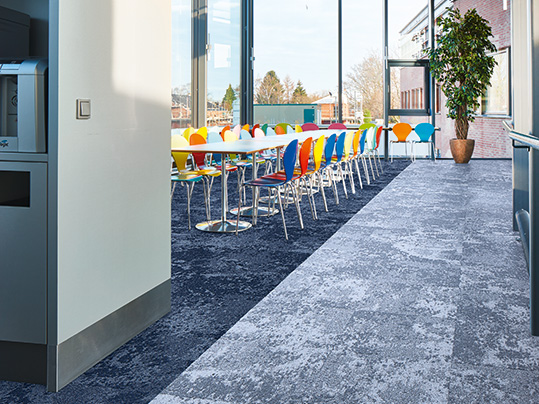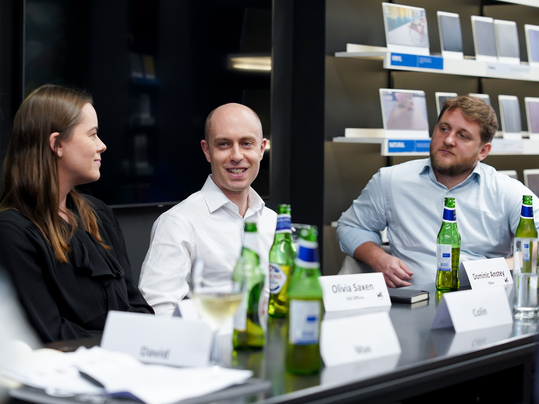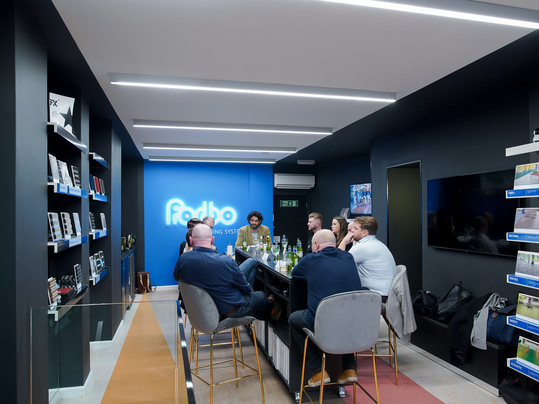Is Cat A+ The Future?
MIX Roundtable Discussion
March 2020

As almost all elements of the commercial workplace are being questioned, and developers are awakening to the need to provide options for tenants who don't want the costs or hassle of creating their own workplace, we teamed up with MIX magazine for a round table discussion on whether Cat A+ is the future?
Kristoff Dubose CEO, Cirkularis8
Dominic Dugan Design Director, Oktra
Jamie Cook Associate Director, Aecom
Colin Wood Director, Colliers
Paul Pennington-Marshall Central London Specification Team Manager, Forbo
Olivia Saxen Head of Interior Design, Kitt Ofices
Max Lishmund Design Principle, Unispace Global
Dominic Anstey Commercial Executive, Mace Interiors

Shared office or ‘co-working’ space is on the rise in major cities, where buildings are increasingly being converted into office spaces and rented by lots of different businesses and entrepreneurs. With this in mind, traditional landlords are now having to consider new ways to market their properties in order to not lose tenants to the co-working phenomenon – and this is where CAT A+ comes into play.
A CAT A+ fit out slots in between CAT A and CAT B and delivers more ready to go elements, such as furniture and internet connections. It is the ideal solution for small businesses that might have struggled to purchase their own office and don’t want to share spaces in a co-working environment.
Renovating empty office space is becoming increasingly popular amongst building owners looking to offer prospective tenants a ready to use "plug and play" workplace. this makes the property more attractive to new occupiers, which in turn ensures that a tenant can be secured quickly and profitably.
Sp why is Cat A+ making waves? Well, it appeals to tenants who struggle to see beyond a standard Cat A finish and wish for their own, private space but with the flexibility coworking offices provide.
There is a lot of noise around the speed of growth of coworking and though the biggest provider only caters for about 1% of London's working population, there is scope for them to gain much more.
Traditional landlords are looking for new ways to market their properties to challenge the co-working phenomenon. the threat of losing tenants to the providers has highlighted a change int he market, driven by a younger generation with a more entrepreneurial spirit than previous generations. Traditional Cat A space is often not what future occupiers want, but Cat A+ is a solution that seems to meet their demands.
Cat A+ makes it possible for small businesses, that might have struggled to fund their own refurbishment and whose only other option would previously have been to share space in a co-working environment, to move into their own fully furnished and functioning office.
So, we start by asking our panel about where the rise of Cat A+ began and, indeed, why?
Dominic D: We were struggling a little with justifying why this thing came about - but actually it's a really healthy thing. It's a really creative thing. The market is fairly traditional and has stagnated somewhat in the way it has been presented. I remember being asked a while back about doing Cat A and my response was "Isn't that just a bunch of white boxes with fancy reception foyers thrown in?". If you were to ask me that question now, I'd probably thrown my whole team at it - such is the level of interest from a designer's perspective and the challenges that it brings; the responsibility it has to entice clients in to those spaces.
When I saw this question about Cat A+ my first thought was where do you stop - because there are so many levels and layers to it.

If you go right to the front door of the building, it really starts with what the building does from a foyer and amenities perspective - which actually justifies the need to do a Cat a+ on an office floor. That's about enabling really good buildings. With new builds, there is always that opportunity to be designed out of the ground, to provide all those amenities and spaces - so there is less pressure to do Cat A+. Existing buildings face different challenges and therefore there's more pressure on making those final spaces - those working floorplates - presentable. This is not just about making the deal easier - it's about the versatility of the market and how co-working has effectively cornered the market, providing a range of scalable offerings. We, as designers, really enjoy this process.
Jamie: I think the term Cat A+ is a fairly new thing to the market, yet clients have been doing this kind of thing for years; they'll take the space and then look to sub-let it, so they build the space and put in the basic finishes and some cellular space maybe...I just think that it's been around a lot longer than people assume - just in a slightly different form. It's gong to be interesting to see where it goes.

Kristoff: I have a real love/hate thing with Cat A+, partly because it makes sense to leave ceilings blank and take all that stuff out and celebrate the services as a trade in its own right. Usually people are really sloppy when it comes to what's behind the ceiling, so if you ever want to expose the ceiling it becomes a huge problem. Also, what's the point in building a whole ceiling that's only going to get ripped out again when you do the Cat B - so in terms of sustainability , that's a big tick.
The problem for me is that, as a small business, we do a lot of small works, and I can't tell you the number of Cat A+ spaces I've gone into where nobody can hear each other. Nobody can talk on the phone -all because all everybody's thought about is how it looks, with the stunning black ceiling, white walls, timber floors and all these hard surfaces - but nobody's thought about the acoustics.
Kristoff cont.: That’s one of the biggest problems in terms of the wellbeing of the people in these spaces – especially as they continue to grow and get bigger. These people then get frustrated and they don’t really know why because they are not part of this industry.
They’ve no idea why it is that people suddenly can’t hear them! There does need to be greater considerations when it comes to how these spaces are used – how these spaces are pulled together. This can be through really simple moves – a bit of acoustics, a bit of baffling on the ceilings. It’s just about taking one extra step on the chessboard.
Is Cat A+ a fad – or a name given to a ‘new’ trend to help developers shift property?
Colin: If you look at the history of Cat A and why it’s there, it’s there for the agents – tenants don’t ask for it, they just want to rip it straight out and landlords don’t want to put it in because it’s wasteful and expensive. What we’ve seen over the past few years is that the space has become more focused on the tenant than it used to be. You get the box provided by the landlord, then the agent puts some Cat A in so that the they can walk the tenant around and they can visualise what the space will look like.
Olivia: One of the things that we do to avoid that – so we don’t do the Cat B or the Cat A+ and then go and rip it apart because the tenant wants something else – is we use technology. So, basically we design the space and then create a VR experience so that tenants can walk into a blank canvas and still see potentially what they could have. We will then co-design the space with the tenant to make sure they get what they need.

Colin: I think that’s a good point. Technology is changing things from that perspective and now allows you to visualise things more easily. If you look at the rise of coworking and flex office…the popularity of that has been driven by tenants who want flexibility in terms of lease terms, the amount of space they take and the provision of amenity space. What that’s done is really force landlords to really take a look at their own offer.
What we are seeing is that a lot of traditional Cat A space has been sat on the market for quite a long time – and as it has flipped into Cat A+ it has massively reduced that void time and made the space more desirable. It has forced landlords to relook at the offer.
Kristoff: You’ve got to have a bike rack these days!
Dominic A: We do a lot of work for landlords and also a lot of work for end users as well. It struck me, looking at this with fairly fresh eyes, that it is quite easy to see how this fits in between a tenant who has the capital, the resources and the confidence in their business in the long-term to commit to a long-term lease and invest in that full Cat B, and somebody who’s a little more developed and a little more mature as a business but doesn’t want to sit in a WeWork – I can see how they fitted into that niche. I do think this is something that’s limited to pretty small floorplates. It’s probably something that landlords can use to push floors that they are struggling to shift. It then started me thinking whether it’s possible to offer a blend of these spaces. If I’m a business and want a bit of flex, I might want four floors in a building, two of which I’m going to fit-out to a full Cat B – with the café, the meeting suite etc – and two floors that are going to be my work floors – open plan offices with rows of desks. So could landlords get that balance of offering combinations of space – possibly with flexible lease terms?

Jamie: I think this is a cap-ex thing as well. This is really catering for the UK market – the majority of which are predominantly SMEs. This really reduces the capital outlay.
Colin: Even some of the bigger clients we are working with really like the flex model.
Olivia: What the Cat A+ model is missing is the service part, which comes afterwards. A lot of these smaller businesses, who graduate from the WeWorks and want their own identities, don’t really want to take over the management of their spaces.
Max: What I really worry about is the brief. If you are speculatively doing this, you’ve got to be very sure of your market before you move into a Cat A+ scenario.
Jamie: There’s no one-size-fits-all scenario here.
Dominic D: I think we’re talking about something quite specific here. When somebody has already made their mind up that they want to do something in a specific way, have complete control, develop the brief with the right third party – then Cat A+ is not for them.
Colin: Where did this genuinely start? Did it start from a genuine demand for plug and play space or is it the result of landlords who are fed up with space that simply won’t shift?
Kristoff: I think it goes back to the point that a lot of companies don’t want to just walk into a white box. The Cat A+ really became a viable route to market for landlords in this town when tech showed up in a big way. Five years ago it was still difficult to convince people to take the ceilings out – now it’s more of a risk to put ceilings in! That has completely flipped.
We move on to talk about sustainability targets and certifications – a subject our panel regards as still red-hot for 2020.
Dominic D: If you look at the data, BREEAM is better than LEED, but both have been corrupted somewhat by the manufacturers – they have been corrupted in their principles by manufacturers who were upset when people said that vinyl flooring is the same as one that is carbon negative. Just look at the data, question it – don’t take my word for it. The environmental side of things will continue to be massive – and not just because of Greta! I don’t think BREEAM and LEED will be at the heart of this – I think there will be something else…
Paul: We hear this from every person who walks through this door – and it’s the first question we’re asked. They look at the bamboo we have, for example, and immediately ask where it came from.
Jamie: When we’re talking to clients we suggest that they just pick the best bits from each – whether that’s LEED, BREEAM, WELL…
Paul: I recently spent 45 minutes standing right here, talking a designer out of vinyl flooring and into Marmoleum – because it is carbon neutral. I was on the verge of getting myself into trouble! But this is my personal belief – and, in this case, I believed this was the best thing for the project. I think you’ve got to take a stance on this.

Just like the majority of the topics we discuss at our Roundtable sessions, Cat A+ will divide opinions. What is for sure is that, for certain businesses, of a certain size, in certain sectors, this is an exciting and more than viable option when it comes to their maturation. And, let’s face it, more choice and greater flexibility can only be a good thing for the tenant.
It certainly was a lively discussion. Want to see the highlights? Then watch our video of the event opposite!